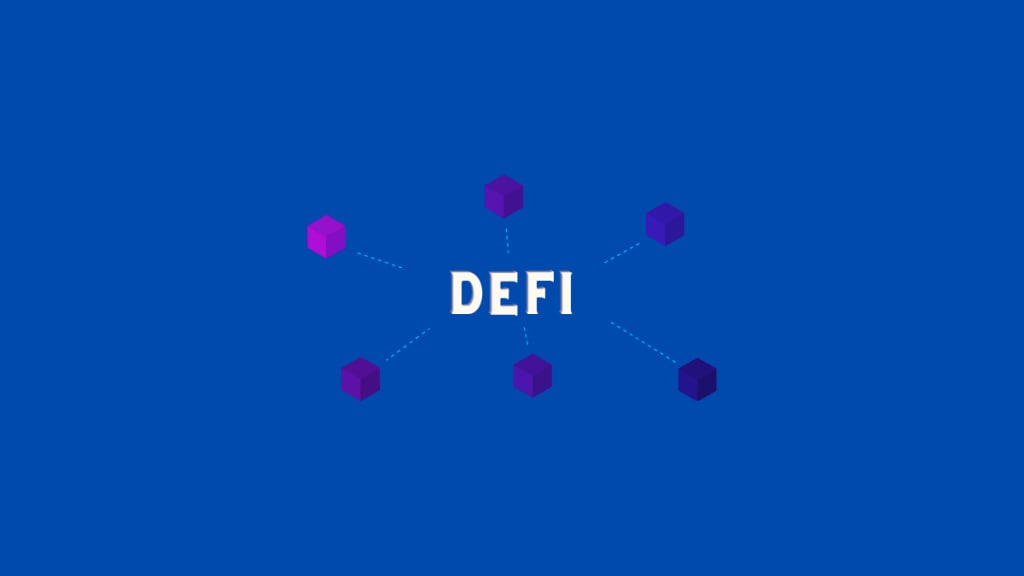A Beginner's Guide to DeFi Staking Development
This guide is designed to help beginners learn more about the development of DeFi staking. It covers topics such as the basics of DeFi staking, the tools and technology used, and the various strategies for creating a successful DeFi staking platform.

Definition of DeFi and staking:
DeFi stands for Decentralized Finance, which is a new financial system built on blockchain technology. It allows people to access financial services without the need for intermediaries like banks or financial institutions.
Staking is a process in which users lock up their cryptocurrency holdings to participate in the consensus mechanism of a blockchain network. In return for staking their tokens, users receive rewards in the form of additional cryptocurrency. DeFi staking refers to the process of staking cryptocurrency in a decentralized finance ecosystem. This can include staking tokens on a DeFi platform, providing liquidity to a liquidity pool, or participating in yield farming. There are several benefits to staking cryptocurrency in a DeFi ecosystem, including Passive income, Higher returns, Decentralization, Flexibility etc,.
The purpose of this guide is to provide an introduction to DeFi staking and its benefits. We'll cover the basics of how DeFi staking works, the benefits of staking cryptocurrency in a DeFi ecosystem, and some examples of popular DeFi staking platforms. By the end of this guide, you should have a good understanding of what DeFi staking is and whether it might be a good investment option for you.
Overview of DeFi Staking:
DeFi staking is a process of earning rewards for holding and locking cryptocurrency in a decentralized finance ecosystem. In this system, users can earn passive income by providing liquidity, participating in yield farming, or staking tokens on a DeFi platform.
- How does DeFi staking work?
In DeFi staking, users can lock up their cryptocurrency holdings for a period of time, typically ranging from a few days to several months. This process of locking up tokens is called staking, and it serves as a way to participate in the network's consensus mechanism and help secure the blockchain network.
As a reward for staking their tokens, users can earn additional cryptocurrency, which is distributed based on the amount of tokens staked and the length of time they are locked up. The rewards can be in the form of interest, transaction fees, or new tokens.
- Comparison to traditional staking:
Traditional staking typically involves holding a specific cryptocurrency and earning rewards in that same currency. DeFi staking, on the other hand, provides more flexibility as users can stake a range of cryptocurrencies and earn rewards in a variety of tokens.
Additionally, DeFi staking is often more accessible and user-friendly than traditional staking, as it doesn't require users to have technical knowledge or run their own nodes.
Examples of DeFi staking projects:
There are several popular DeFi staking projects, including:
- Ethereum 2.0 - Ethereum's transition to a proof-of-stake consensus mechanism allows users to stake their ETH holdings and earn rewards.
- Uniswap - The decentralized exchange Uniswap offers liquidity providers the opportunity to earn rewards for providing liquidity to trading pairs.
- Aave - The decentralized lending platform Aave allows users to earn interest on their cryptocurrency holdings by staking them as collateral.
- PancakeSwap - A Binance Smart Chain-based DEX, PancakeSwap allows users to earn rewards by staking their tokens in liquidity pools.
In conclusion, DeFi staking offers an opportunity for users to earn rewards on their cryptocurrency holdings while participating in a decentralized finance ecosystem. With the growth of DeFi, it's likely that we'll see more innovative staking models and projects emerge in the future.
DeFi Staking Development
Why build a DeFi staking project?
DeFi staking has gained popularity in recent years, as it allows investors to earn passive income by holding and staking their cryptocurrency assets in a decentralized manner. This has led to the development of various DeFi staking projects, each with its unique features, benefits, and risks. Some reasons to build a DeFi staking project could include:
- Meeting the demand for decentralized staking solutions.
- Creating a new revenue stream for investors and the project team.
- Enhancing the security and decentralization of the blockchain ecosystem.
- Providing an alternative to traditional staking options.
Steps to developing a DeFi staking project
- Define project goals: Determine the objectives of the project, target audience, and the type of staking mechanism to be used.
- Choose a blockchain platform: Select the blockchain platform that aligns with the project's goals, considering factors such as speed, security, scalability, and community support.
- Select a programming language and tools: Choose a programming language and development tools that are compatible with the blockchain platform.
- Design the architecture: Create the system architecture, including the user interface, smart contract logic, and backend functionalities.
- Implement smart contracts: Develop smart contracts to implement the staking mechanism, including the staking, reward distribution, and penalty mechanisms.
- Testing and debugging: Perform thorough testing and debugging to ensure the smart contracts are secure and function as intended.
- Challenges in DeFi staking development
- Security risks: DeFi staking projects are prone to various security risks, including smart contract vulnerabilities, hacking attacks, and phishing scams.
- Regulatory compliance: DeFi staking projects may be subject to regulatory scrutiny, and compliance with relevant laws and regulations may be a challenge.
- User adoption: The success of a DeFi staking project relies heavily on user adoption, which can be challenging to achieve in a crowded market.
Best practices in DeFi staking development
Security first: Security should be the top priority when developing DeFi staking projects. Conduct thorough security audits and implement necessary measures to mitigate potential risks.
- User-centered design: Develop user-friendly interfaces and prioritize user experience to improve user adoption and retention.
- Transparent reward distribution: Ensure that the reward distribution mechanism is transparent and fair, as this can help build trust and confidence in the project.
- Regulatory compliance: Stay up-to-date with regulatory developments and ensure compliance with relevant laws and regulations to avoid legal issues.
- Community building: Build an active community around the project, engage with users, and listen to their feedback to improve the project's features and functionality.
Staking Tokens and Rewards
- Staking Tokens in a DeFi Project: Staking tokens in a DeFi project involves holding tokens in a wallet and locking them up for a certain period to earn rewards. Staking helps secure the blockchain network, and it is an essential component of many DeFi projects. When tokens are staked, they are held in a smart contract, and the staker is granted certain privileges, such as voting rights, reward distribution, or access to certain functionalities.
- Token Economics and Rewards: Token economics refer to the design and distribution of tokens in a DeFi project. The token economics of a project can affect the rewards and incentives for staking. Token rewards can be distributed in different ways, such as a fixed percentage of the staked tokens or through an inflationary model, where new tokens are minted and distributed as rewards.
- Staking and Unstaking Tokens: To stake tokens in a DeFi project, a user needs to transfer the tokens to the designated staking contract, usually through a user interface. The tokens are then locked up for a specific period, and the user can earn rewards based on the staked amount and duration. To unstake tokens, the user needs to initiate an unstaking transaction, which typically requires a waiting period before the tokens are released back to the user's wallet.
- Calculating Rewards and Payouts: The calculation of rewards and payouts for staking tokens can vary depending on the token economics of the project. In general, the rewards for staking are distributed based on the staker's share of the total staked tokens in the network. The rewards can be distributed daily, weekly, or monthly, depending on the project's design. The calculation of rewards and payouts is usually automated through smart contracts, which execute the reward distribution process based on pre-defined rules.
In summary, staking tokens in a DeFi project involves locking up tokens for a specific period to earn rewards, which are distributed based on the project's token economics. Staking and unstaking tokens can be initiated through a user interface, and the calculation of rewards and payouts is usually automated through smart contracts.
Security Considerations
Security is a critical consideration for any DeFi staking platform, as the nature of the technology involved and the value at stake make it an attractive target for attackers. Here are some important security measures and considerations for DeFi staking:
- Smart contract security auditing: The smart contract code that governs the staking process must be audited by independent security firms to ensure that it is secure and free from vulnerabilities. Auditors can help to identify potential exploits, code errors, and other issues that could be exploited by attackers.
- Regular penetration testing: In addition to auditing the smart contract code, regular penetration testing should be conducted to test the platform's security controls and identify any vulnerabilities. Penetration testing involves simulating attacks against the platform to identify weaknesses and evaluate the effectiveness of the security measures in place.
- Multi-factor authentication: Multi-factor authentication should be implemented to protect user accounts and prevent unauthorized access. This can include the use of passwords, security tokens, biometric authentication, and other forms of identification.
- Cold storage of funds: A significant amount of the staked funds should be kept in cold storage, offline wallets, which can reduce the risk of theft in the event of a security breach.
- Continuous monitoring: The platform should be continuously monitored for suspicious activity, such as unusual withdrawal requests, unauthorized changes to the smart contract code, or unexpected changes in user behavior. Monitoring tools can alert the platform's security team to potential security breaches so they can take immediate action.
- Insurance coverage: Platforms can consider purchasing insurance coverage against losses resulting from security breaches or other types of hacking attacks.
In summary, DeFi staking platforms must take a multi-layered approach to security to protect the funds and information of their users. This requires a combination of technical measures, such as smart contract auditing and penetration testing, and operational measures, such as multi-factor authentication and continuous monitoring, to ensure that the platform remains secure over time.
Recap of key points:
- DeFi staking is a process where users can lock up their cryptocurrency assets in a smart contract in exchange for rewards.
- Security is a critical consideration for DeFi staking platforms and requires a multi-layered approach to protect user funds and information.
- Some important security measures for DeFi staking include smart contract security auditing, regular penetration testing, multi-factor authentication, cold storage of funds, continuous monitoring, and insurance coverage.
Future of DeFi staking development:
DeFi staking is still a relatively new concept, and the development of new platforms and features is ongoing. Some potential future developments in DeFi staking could include the integration of additional cryptocurrencies, the use of more sophisticated algorithms for reward distribution, and the implementation of more advanced security measures.
Final Thoughts:
A DeFi staking development company is a firm that specializes in creating and maintaining decentralized finance staking platforms and related technologies to facilitate the staking of cryptocurrency assets.
About the Creator
Jade Mckinley
Jade Mc, a senior specialist as a content writer, has more than 5 years of experience in this field. She is well-known for her critical review of the blockchain industry and crypto projects.






Comments
There are no comments for this story
Be the first to respond and start the conversation.